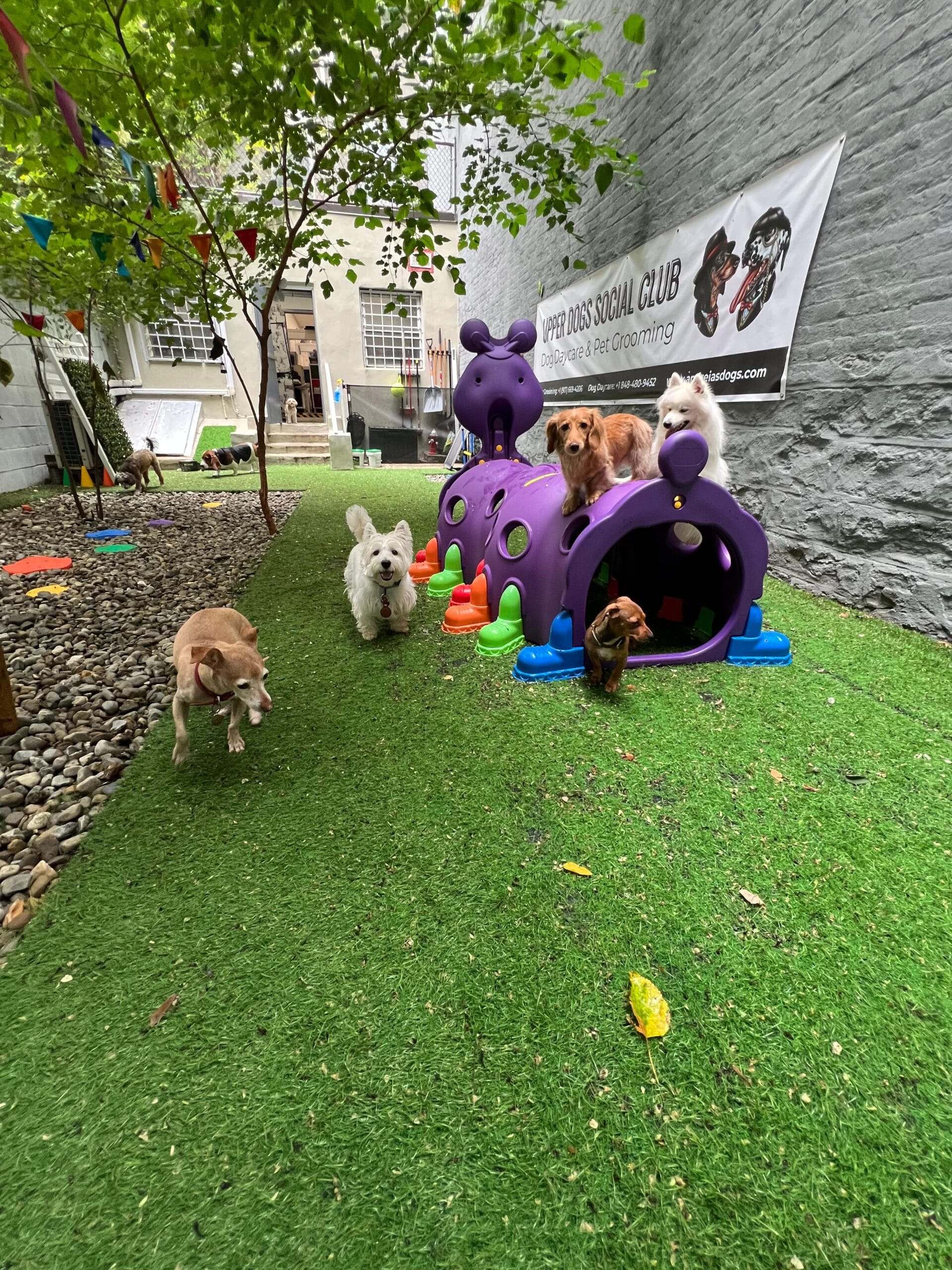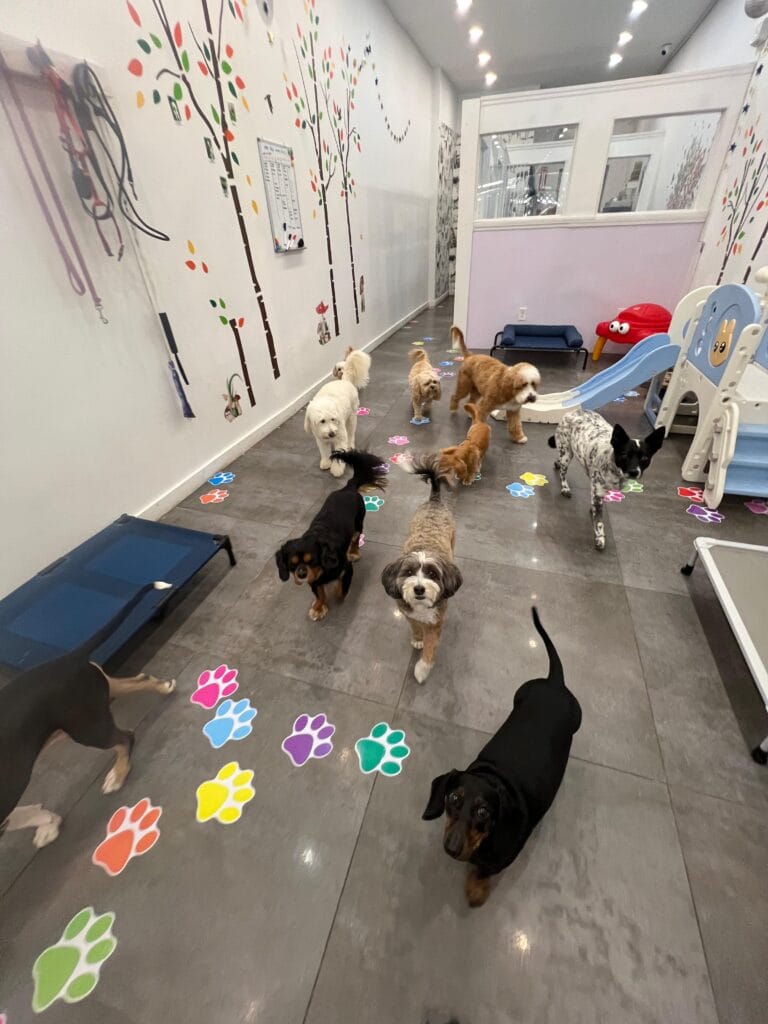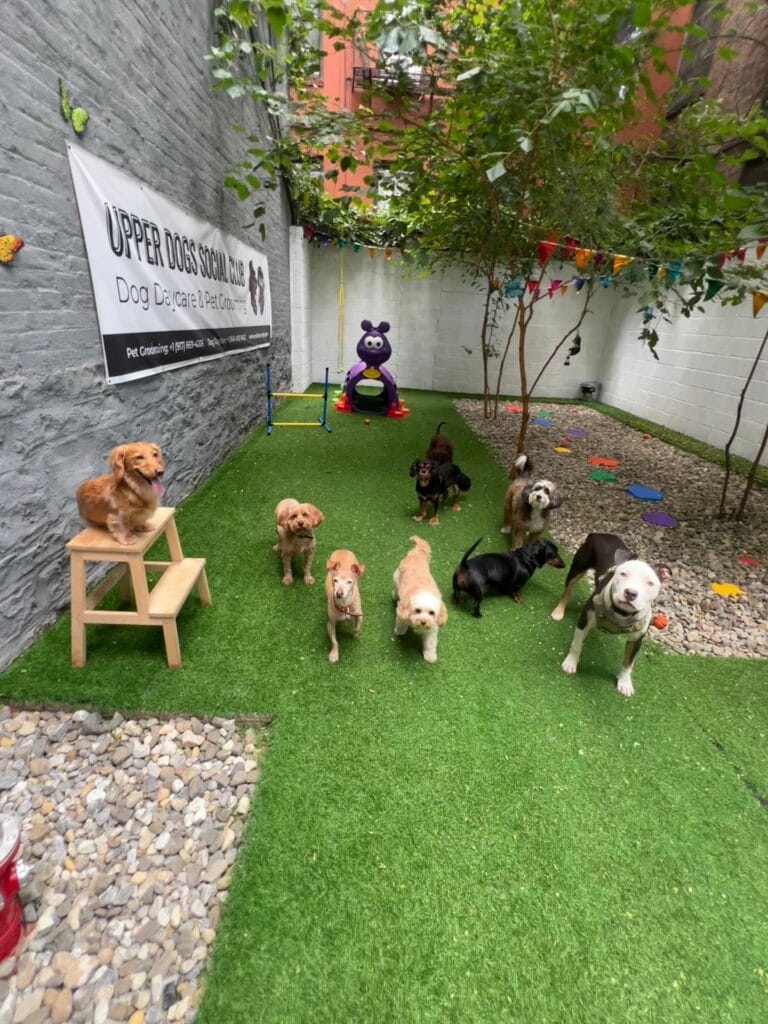Your dog’s first day at Manhattan daycare can feel overwhelming for both of you. This guide is for pet parents who want their furry friend to have a smooth, successful start at doggy daycare.
Getting your pup ready involves more than just showing up with their favorite toy. We’ll walk through the essential health and safety requirements every Manhattan daycare expects, plus help you build your dog’s socialization skills so they can make friends fast. If you’re still choosing the right facility, our guide to Dog Daycare in East Harlem, Manhattan NYC highlights what to look for in a safe, reliable daycare experience. You’ll also learn which basic obedience commands will set your pup up for success and discover proven strategies to prevent separation anxiety from turning drop-off into a daily struggle.
Essential Health and Safety Requirements
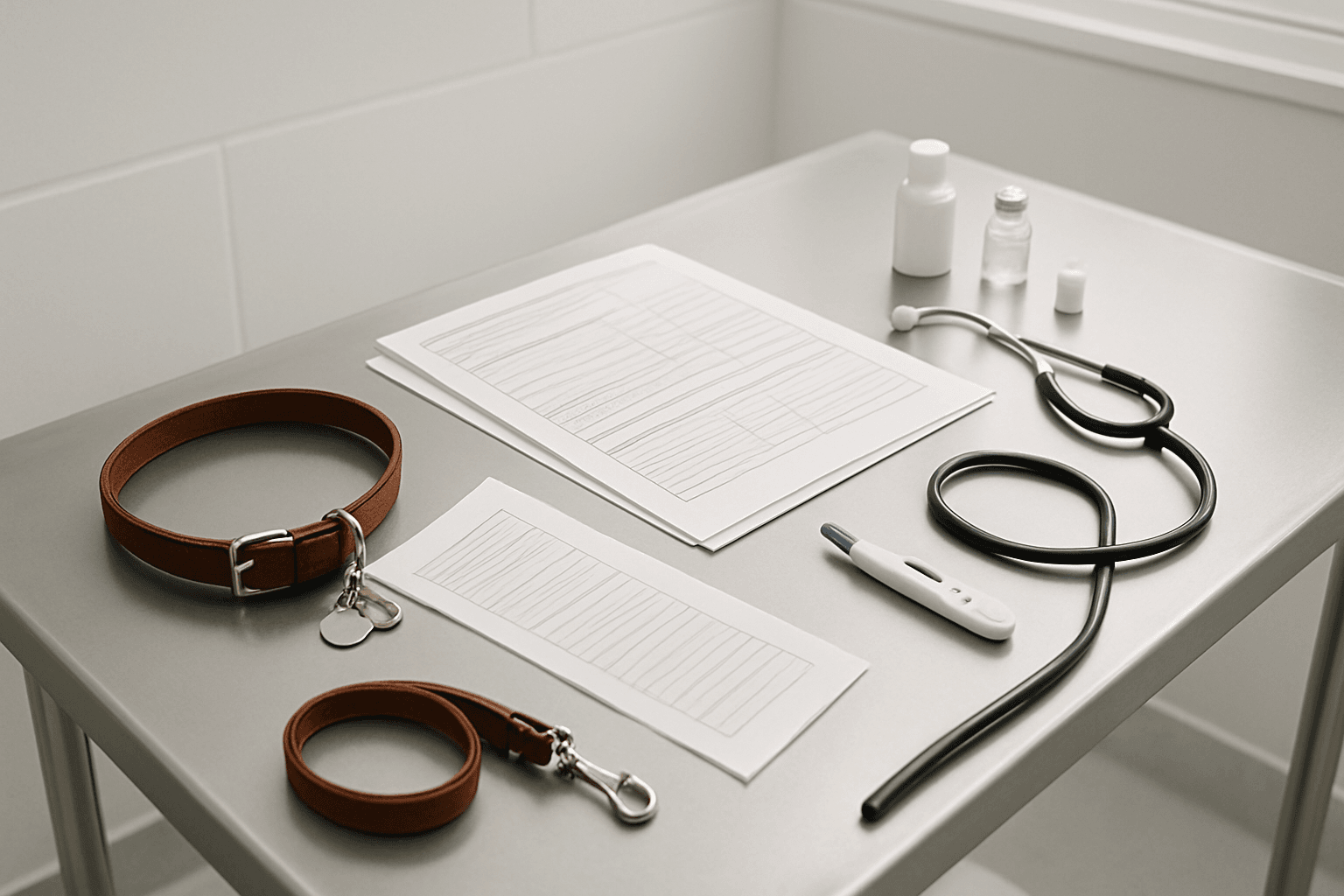
Complete vaccination records and health certificates
Your dog needs up-to-date vaccinations before stepping paw into any Manhattan daycare facility. Most reputable daycares require proof of rabies, DHPP (distemper, hepatitis, parvovirus, and parainfluenza), and bordetella vaccines, following the core vaccination guidelines outlined by the American Veterinary Medical Association (AVMA).
The rabies vaccine must be current and administered by a licensed veterinarian, typically valid for one to three years depending on the vaccine type and local regulations. You can find official rabies prevention guidelines on the CDC’s Rabies Information page to ensure your dog meets all safety requirements.
The DHPP combination vaccine protects against four serious diseases that spread easily in group settings. Parvovirus, in particular, can be devastating in daycare environments where multiple dogs interact. Bordetella, commonly known as kennel cough, is highly contagious and often required to be updated every six months for dogs in social settings.
Beyond standard vaccines, many Manhattan daycares now require the canine influenza vaccine, especially after outbreaks in recent years. This vaccine comes in two forms: H3N8 and H3N2, with some facilities requiring both strains. To learn more about how Manhattan facilities maintain strict hygiene and illness-prevention policies, check out Prioritizing Safety: Dog Daycare Protocols in Urban Environments for an inside look at the safety standards that protect every pup.
You’ll need a health certificate from your veterinarian confirming your dog is in good health and free from contagious diseases. This certificate should be recent, typically within 30 days of your dog’s first day. The vet will check for any signs of illness, skin conditions, or parasites that could affect other dogs in the facility.
Flea and tick prevention protocols
Manhattan’s urban environment doesn’t make dogs immune to fleas and ticks. These parasites can quickly spread throughout a daycare facility, creating problems for all the dogs and their families. As part of a broader commitment to safety, our article Prioritizing Safety: Dog Daycare Protocols in Urban Environments explores how reputable Manhattan facilities maintain strict hygiene and health standards to protect every pup in their care.
Most facilities accept monthly topical treatments, oral medications, or flea and tick collars as acceptable prevention methods. For guidance on safe, veterinarian-approved prevention options, visit the ASPCA’s Flea and Tick Control resource. The key is consistency – your dog needs to be on a regular prevention schedule, not just treated when you notice a problem.
Some daycares perform quick visual inspections during drop-off, looking for signs of flea dirt or actual parasites. If they spot anything suspicious, your dog might be sent home until the issue is resolved. This policy protects all the dogs in their care and prevents infestations that could shut down the facility.
Keep your prevention schedule documented and bring records showing when treatments were applied. If you’re switching prevention methods, discuss the timing with your vet to avoid gaps in protection that could leave your dog vulnerable.
Spaying or neutering documentation
Most Manhattan daycares require dogs over six months old to be spayed or neutered before joining group activities. As the Humane Society explains, the procedure not only prevents unwanted breeding but also promotes better behavior and overall health.
Your veterinarian will provide documentation after the surgery, typically including the date of the procedure and confirming the surgery was completed successfully. Keep this certificate safe, as you’ll need it for daycare registration and potentially for other services like grooming or boarding.
If your dog isn’t yet old enough for the procedure, some daycares offer puppy programs for dogs under six months. However, once your pup reaches the age requirement, you’ll need to schedule the surgery to continue daycare services. Plan ahead, as recovery time means a temporary break from daycare activities.
Intact dogs can display territorial behaviors, mounting, or increased reactivity that disrupts the group dynamic. Spaying and neutering significantly reduces these behaviors, making daycare a more enjoyable experience for your dog and their new friends.
Socialization Skills Development
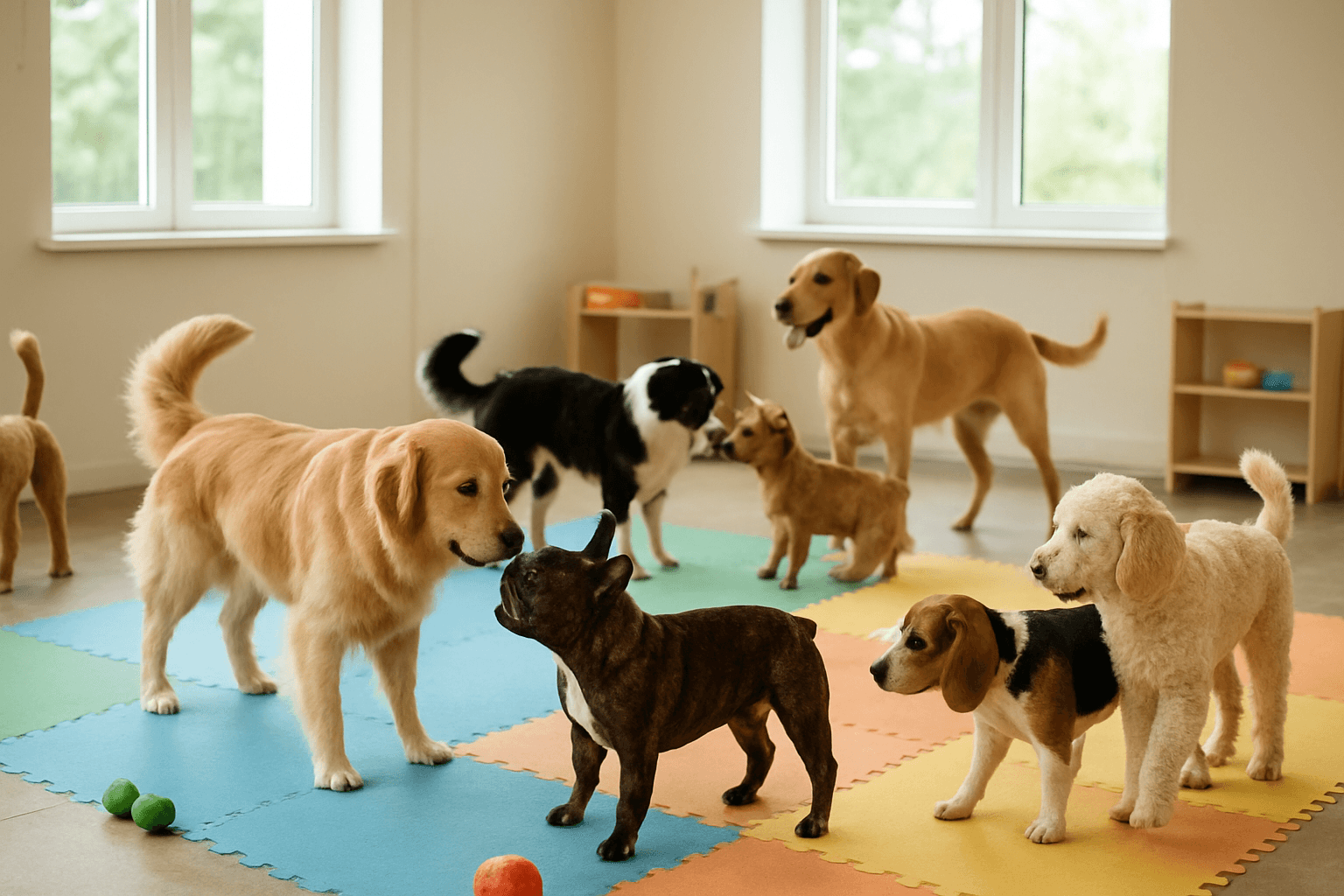
Controlled Introductions to New Dogs
Getting your dog comfortable meeting new canine friends takes patience and careful planning. Start with one-on-one meetups in neutral territory like a park or sidewalk before attempting group interactions. As you work on social confidence, our post Boosting Social Skills: How Dog Daycare Benefits Your NYC Pup explains how structured daycare environments can help dogs develop positive play habits and strengthen their social skills even further.
Keep first meetings short – just 5-10 minutes – and watch your dog’s body language closely. Signs of stress include excessive panting, tucked tail, or trying to hide behind you. Positive interactions show relaxed body posture, play bows, and gentle sniffing. If your dog seems overwhelmed, create distance and try again another day.
Practice parallel walking with another dog and owner, maintaining several feet between the animals. This teaches your dog that other dogs can be nearby without direct interaction being necessary. Gradually decrease the distance as your pet becomes more comfortable.
Exposure to Different Handlers and Environments
Manhattan daycare facilities employ multiple staff members, so your dog needs to feel secure with various handlers. Arrange meetups with different friends, family members, and neighbors who can practice basic commands with your pet. Each person should use the same commands and reward system you’ve established at home.
Visit different locations regularly – busy streets, parks with playground equipment, areas with various sounds and smells. Urban environments present unique challenges like sirens, construction noise, and crowds of people. Start with quieter locations and gradually work up to busier areas.
Practice having strangers approach and pet your dog while you’re present. Many daycare situations involve unfamiliar people, so your dog should accept gentle handling from staff members—something especially important if you’re considering Dog Daycare Solutions for Busy NYC Professionals: A Lifesaver. Reward calm behavior during these interactions with treats and praise.
Comfort with Group Feeding and Playtime
Resource guarding can become problematic in daycare settings where multiple dogs share space during meals and play. Practice feeding your dog near other animals, starting with just one other pet at a safe distance. Gradually move food bowls closer as your dog remains relaxed and focused on their own meal.
Teach your dog to wait patiently while you prepare food and to eat only from their designated bowl. Practice interrupting meals occasionally by calling your dog away from their food, then allowing them to return. This prevents possessive behavior and shows that food interruptions don’t mean meal time is over.
Group play requires sharing toys and space with others. Rotate toys regularly at home and practice the “drop it” command so your dog releases items when asked. Once your dog becomes comfortable with shared play, you can plan their daycare attendance more confidently — our guide on How Often Should Your Dog Attend Daycare in Manhattan NYC? explains how to determine the ideal schedule based on your dog’s social readiness and energy level.
Basic Obedience Command Mastery

Reliable Recall in Distracting Environments
Your dog’s ability to come when called becomes absolutely critical in a daycare setting where excitement levels run high and distractions are everywhere. Start practicing recall in your backyard or a quiet park, then gradually increase the difficulty by adding other dogs, people, toys, and food smells to the mix. The key is building up your dog’s response gradually rather than expecting perfect performance in chaos right away.
Practice the “come” command during playtime when your dog is naturally having fun. This creates positive associations with returning to you rather than viewing recall as the end of all good things. Use high-value treats, enthusiastic praise, and even brief play sessions as rewards. Never call your dog to come and then immediately end their fun activity – this teaches them that coming to you means the party’s over.
Work on recall at different distances and with varying levels of distraction. Start at arm’s length, then move to across the room, then across the yard. Add bouncing balls, squeaky toys, and other dogs one at a time. Manhattan daycare environments are sensory overload for most dogs, so your practice sessions need to reflect that reality.
Sit and Stay for Safety Protocols
Daycare facilities rely heavily on dogs following basic positioning commands to maintain order during transitions, feeding times, and group activities. Your dog needs rock-solid sit and stay commands that work even when other dogs are moving around, staff members are bustling about, and excitement fills the air.
Build duration gradually with the stay command. Start with just three seconds, then five, then ten, working up to at least two minutes of reliable staying power. Practice in different locations throughout your home – the kitchen during meal prep, the living room with the TV on, near the front door when visitors arrive. Each new environment teaches your dog that “stay” means the same thing regardless of what’s happening around them.
The emergency stop is particularly important for daycare safety. Your dog should be able to sit immediately when requested, even if they’re mid-play session with another dog. This prevents situations from escalating and allows staff to redirect behavior quickly. Practice interrupting play sessions at home with a firm “sit” command, rewarding compliance with return to play rather than just treats.
Leash Walking Without Pulling or Lunging
Proper leash manners make arrival and departure at daycare smooth and safe for everyone involved. Dogs who pull, lunge, or get overly excited on leash create stressful situations that can trigger reactive behaviors in other dogs. Your preparation should focus on creating a calm, controlled dog who can navigate busy sidewalks and facility entrances without drama.
Start with basic loose-leash walking in low-distraction areas, rewarding your dog for staying beside you rather than forging ahead. Use positive reinforcement techniques like treat rewards for checking in with you, changing direction when your dog pulls, and stopping forward movement whenever tension appears on the leash. The goal is teaching your dog that pulling gets them nowhere, while walking nicely gets them where they want to go.
Practice specific daycare scenarios at home. Walk past other dogs at a distance, approach building entrances with excitement, and navigate crowded areas where your dog might encounter unexpected sights and sounds. Manhattan streets present unique challenges with their constant activity, so expose your dog to urban environments gradually while maintaining training standards.
Separation Anxiety Prevention Strategies
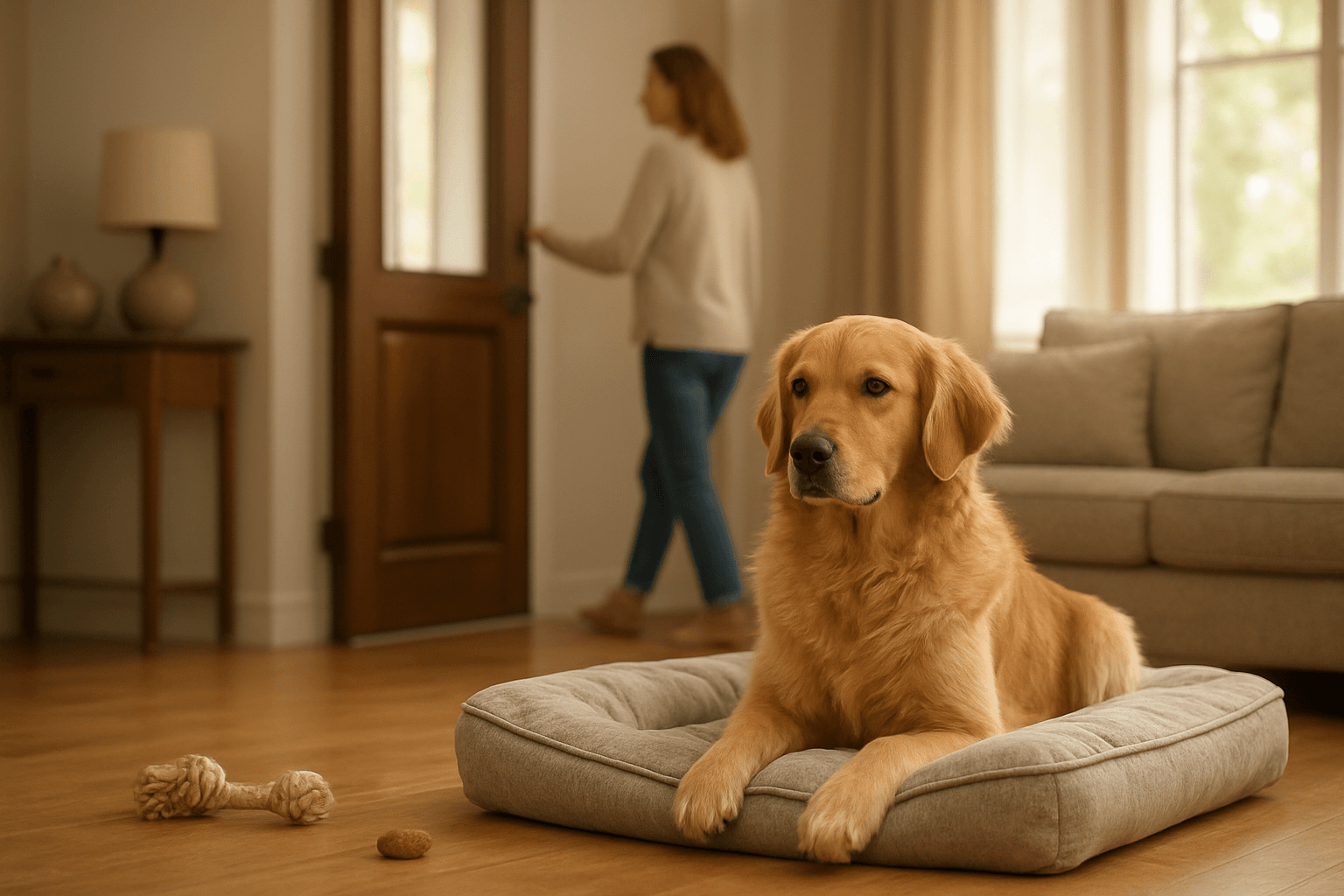
Gradual Alone Time Practice at Home
Start building your dog’s independence weeks before their first daycare visit by implementing structured alone time sessions at home. The American Kennel Club (AKC) offers expert advice on preventing separation anxiety and helping your pup adjust to time apart. Gradually increase these intervals by 5-10 minutes each day until your pup can comfortably handle 2-3 hours alone.
Create a designated “safe space” in your home where your dog feels secure during practice sessions. This might be a specific room, crate, or corner with their favorite blanket and toys. Practice your actual departure routine – grab your keys, put on your coat, and walk out the door just as you would on a daycare morning. This repetition helps your dog understand that departures are temporary and routine.
Avoid making a big deal about leaving or returning. Skip the dramatic goodbyes and excited hellos that can heighten your dog’s emotional response to separations. Instead, keep departures calm and matter-of-fact, treating them as normal parts of daily life.
Short Trial Visits to Build Confidence
Schedule brief meet-and-greet sessions at your chosen daycare facility before committing to a full day. Many quality daycares offer 30-minute to 2-hour trial visits that allow your dog to explore the environment, meet staff members, and interact with other dogs in a controlled setting. For a deeper look at what makes these facilities stand out, check out What to Expect from a Premier Dog Daycare in Manhattan — it offers valuable insight into the environment, care standards, and daily routines that define top-tier Manhattan daycares.
During these visits, observe how your dog responds to the new environment and social dynamics. Look for signs of stress like excessive panting, pacing, or withdrawal, as well as positive indicators such as play behavior and curiosity about their surroundings. These trial runs provide valuable insights into your dog’s readiness and help identify any areas that need additional preparation.
Ask daycare staff about their introduction process and what they observe during your dog’s trial visits. Their professional assessment can guide your preparation strategy and timeline for full enrollment.
Comfort Items and Morning Routine for Smooth Drop-Offs
Establish a consistent morning routine that signals daycare days to your dog. This predictable sequence of events – perhaps breakfast, a short walk, and then car time – creates structure and reduces anxiety through familiarity. Dogs thrive on routine, and knowing what comes next provides emotional security during transitions.
Pack a small comfort item from home, such as a favorite toy or piece of clothing with your scent. Check with your daycare about their policy on personal items, as some facilities prefer to use their own toys for hygiene reasons. If personal items aren’t allowed, consider bringing the same type of treat each day to create a positive association with drop-off time.
Keep morning goodbyes brief and upbeat. Lingering at drop-off often increases your dog’s stress levels and can trigger separation anxiety. A quick, confident departure shows your dog that you trust the environment and staff, which helps them feel more secure about staying behind.

Conclusion
Getting your furry friend ready for their Manhattan daycare adventure takes some planning, but the effort pays off big time. Making sure they’re healthy, well-socialized, and comfortable being away from you sets them up for success from day one. Teaching basic commands like sit, stay, and come helps them navigate their new social environment with confidence.
The best part about proper preparation is watching your dog thrive in their daycare community. Start working on these skills a few weeks before their first day, and don’t rush the process. If you’re exploring trusted options for your pup’s care, check out Pet Care Services in Manhattan NYC to discover how local providers like Andreia’s Dogs offer personalized, professional attention that helps every dog feel secure, happy, and ready to make new friends.
Frequently Asked Question (FAQs)
Most Manhattan dog daycares require proof of up-to-date rabies, DHPP (distemper, hepatitis, parvovirus, parainfluenza), and bordetella vaccines. Many facilities also recommend or require the canine influenza (H3N8 and H3N2) vaccine due to recent outbreaks. Always bring a current health certificate from your vet confirming your dog is healthy and parasite-free.
Start by arranging controlled introductions with calm, friendly dogs in neutral spaces. Practice parallel walks and short meetups to build comfort gradually. Expose your dog to different people, sounds, and environments to simulate the daycare setting and reduce anxiety around new experiences.
Yes — most daycares in Manhattan require dogs over six months old to be spayed or neutered. This helps prevent aggressive or territorial behavior, reduces stress in group settings, and ensures safer playtime for all dogs. Some facilities may offer puppy programs for younger, intact dogs until they reach the required age.
Practice short alone-time sessions at home leading up to daycare and gradually increase their duration. Schedule a trial visit to familiarize your dog with the new environment. On daycare mornings, keep goodbyes brief and calm, and send a comfort item like a favorite toy or blanket if the facility allows it.
Establish a consistent morning routine—breakfast, short walk, and then daycare. This predictability helps your dog feel secure. Bring required paperwork, labeled items, and arrive a few minutes early for check-in. Stay upbeat and confident during drop-off; dogs mirror your energy, so your calmness will help them relax and settle in quickly.

